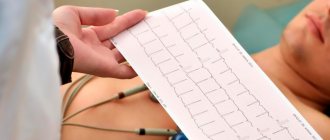Diseases of the cardiovascular system in old age
Healthy and sick people strive to include everything “delicious” in their daily diet: caviar, salted fish, marinades, smoked and fatty meat delicacies, rich broths, vinegar-based seasonings, sweet dairy products, cakes, sweets, juices identical to natural ones. Our body is ready to process everything to obtain vital energy. But at what cost?
A direct relationship between nutrition and human diseases has been scientifically proven. Nutritionists have developed recommendations for the treatment of diseases and developed methods of therapeutic fasting. There are 15 dietary tables as a basis for creating individual diets.
Cardiovascular diseases occupy the first place in the world in terms of mortality. Most deaths occur outside the hospital. Doctors have little ability to provide effective and safe care. Arterial hypertension, atherosclerosis, coronary heart disease and their complications, myocardial infarction, strokes must be treated comprehensively and continuously. Proper nutrition for cardiovascular diseases enhances the effect of medications, increases their effectiveness, and increases the life expectancy of patients. In addition, a healthy diet helps prevent cardiovascular diseases in the presence of risk factors and hereditary predisposition.
Risk factors for developing cardiovascular diseases
- Age. People over 40 years of age become ill more often.
- Floor. Men get sick more often than women.
- Heredity.
- Smoking.
- High blood pressure.
- High levels of cholesterol and other indicators of fat metabolism.
- Diabetes.
- Frequent emotional stress, extreme living conditions.
- Characteristics of a person. Aggressive, intolerant people, as well as those who take everything “to heart,” suffer from these diseases more often.
- Sedentary lifestyle.
- Obesity.
- Excessive alcohol consumption.
Prevalence of hypertension
Arterial hypertension is a disease the main symptom of which is high blood pressure, not associated with disease of the internal organs. Arterial hypertension affects 20-30% of the adult population. With age, their number increases and reaches 50-60% among people over 65 years of age. A prolonged increase in blood pressure contributes to damage to the heart, brain, kidneys and blood vessels.
Malnutrition and hypertension
The functioning of the cardiovascular system is closely related to nutritional processes. Eating large amounts of food fills the stomach, which can dislocate the diaphragm and make it difficult for the heart to function. Overload is also created by drinking too much liquid. If there is a lot of salt in food, then water is retained in the body tissues, which contributes to increased blood pressure and the appearance of edema. Treatment and prevention of exacerbations of arterial hypertension are carried out under the supervision of the attending physician after a mandatory examination. Drug therapy, therapeutic exercises and nutritional correction with diet No. 10 are prescribed individually.
Diet principles
Following a diet must be a conscious choice of the patient; the doctor cannot force him to follow the necessary recommendations!
How to eat properly with arterial hypertension? The purpose of diet No. 10 is to provide favorable conditions for the functioning of the circulatory system, prevent high blood pressure, and reduce the load on the digestive organs and kidneys.
- Table salt must be limited; over-salting food is unacceptable. It is recommended to cook food without salt and only add a little salt to already cooked dishes. The taste of under-salted food can be improved by adding citric acid, cinnamon, parsley, cilantro or dill to dishes. Gradually, unsalted food becomes habitual.
- To improve the functioning of the heart muscle and remove excess fluid from the body, foods containing potassium are needed. There are a lot of potassium salts in vegetables, fruits, berries, and juices. Cabbage, pumpkin, apricots, as well as prunes, dried apricots, raisins, and rose hips are especially rich in them.
- Magnesium salts are very important; they have a vasodilating effect and help prevent vascular spasms. Rye and wheat bread with bran, oatmeal, millet, barley, buckwheat porridge (puddings, casseroles) are sources of magnesium. There is a lot of Mg in carrots, beets, lettuce, parsley, black currants, and nuts.
- The consumption of strongly brewed tea and coffee should be avoided; they have a stimulating effect on the cardiovascular and nervous system. Caffeine and other stimulants in tea and coffee can cause increased heart rate, insomnia, and high blood pressure.
- In order not to overload the cardiovascular system, you should reduce the total amount of fluid to 1-1.2 liters. per day, including tea, compote, milk, soup. It is recommended to give preference to vegetable, fruit, cereal, and dairy soups.
- Meat and fish broths are acceptable, but not more than twice a week. It is better to boil poultry and veal meat, then it will contain fewer extractive substances that stimulate the cardiovascular system.
- Limit consumption of foods high in animal fats. Animal fats increase the risk of developing atherosclerosis and obesity. Vegetable salads are best seasoned with any vegetable oil.
- Patients are often overweight, so it is important to gradually lose weight. When body weight decreases by 10% from the original, blood pressure figures decrease by 5-10 mmHg. It is necessary to reduce the caloric content of food intake by limiting the consumption of sugar, jam, flour products, bread, etc. Fasting days in this case are very effective (their appointment is possible only after the recommendation of the attending physician), they are usually arranged once a week, preferably on a day off. For example, cottage cheese: 300-400 g of low-fat cottage cheese for 5 doses, 2 glasses of kefir, 1-2 cups of weak and unsweetened tea or coffee. Apple: 1-1.5 kg of apples for 5 doses.
- During the day, you need to eat small portions approximately every 2.5-3 hours.
To provide the body with the necessary amount of proteins, fats and carbohydrates, it is important to observe their content in foods.
For an adult:
- Proteins – at least 80 g, of which animal proteins – at least 50 g.
- Fats – 65-70 g, of which animal fats – 50 g.
- Carbohydrates – 350-400 g.
- Table salt – 6 g.
- The number of calories per day is 2500-2800 kcal.
- The total amount of liquid drunk is 0.8 l.
Prevalence of atherosclerosis
Deterioration of memory for recent events, emotional instability are the initial manifestations of sclerosis.
Atherosclerosis of the vessels of the heart, brain, and lower extremities is actually very common. Despite advances in medicine, the first heart attack still ends in death in every third patient. The financial and human losses associated with this disease are very high. This is a problem in modern society.
Development of atherosclerosis
Atherosclerosis is a chronic, progressive disease that affects the arteries. Fat-like substances, primarily cholesterol, penetrate their walls. An atherosclerotic plaque gradually forms, which, increasing, makes the lumen of the artery narrower, complicating blood circulation.
Atherosclerosis is a slowly developing disease. Poor nutrition, smoking, alcohol consumption, hypertension, diabetes mellitus, and high blood cholesterol levels contribute to its development. Vascular atherosclerosis occurs in people after 25-30 years of age and initially does not manifest itself in any way. Gradually, the vessels lose their elasticity, their lumen narrows, organs and tissues do not receive oxygen and nutrients. Areas of circulatory disturbance form. Complications such as coronary heart disease, myocardial infarction, and cerebral stroke may occur.
Most experts currently consider elevated blood cholesterol levels to be one of the main causes of atherosclerosis. Cholesterol is found only in animal fats. Cholesterol is necessary for the body to synthesize bile and sex hormones; each cell contains it as part of the membrane. According to modern doctors, the level of cholesterol in the blood plasma should not exceed 5.2 mmol/l. Mild hypercholesterolemia is diagnosed at a cholesterol level of 5.2-6.5 mmol/l, moderate - at 6.5-7.8 mmol/l, severe - at 7.8 and above.
Prevention of atherosclerosis development
To prevent coronary heart disease and atherosclerosis, a gradual but sustainable change in nutrition is necessary. You should reduce your consumption of foods containing cholesterol, animal fats, salt and alcohol.
If, after an examination, your attending physician diagnoses you with atherosclerosis or increased cholesterol in the blood, do not despair.
Proper nutrition will help you normalize blood cholesterol levels in case of heart disease, delay the development of atherosclerosis, and significantly reduce the likelihood of heart attacks and strokes. Your blood vessels will remain “clean” and healthy longer. This will prolong youth and life. If necessary, your individual attending physician will select drug therapy to lower cholesterol.
Nutrition rules
12 basic nutritional rules for people with high blood cholesterol, atherosclerosis and other heart diseases.
- Food should be varied. Try to use at least 20 types of products during the day. You will provide the body with the necessary substances.
- Replace meat with fish, poultry, legumes (peas, beans, lentils). Give preference to lean meats; remove visible fat from meat and skin from chicken. Portions of meat, fish or poultry should be small (90-100g when cooked); red meat (beef, lamb) is best cooked less than 2 times a week. Sausages, sausages, smoked meats, hamburgers, hot dogs, lard, pates, chips should be excluded.
- When cooking, use vegetable oils: olive, corn, sunflower, soybean up to 2 tablespoons per day and “soft” margarines.
- It is recommended to consume no more than 2-3 egg yolks per week.
- Limit your consumption of offal.
- Try to include confectionery, ice cream, and ice cream in your diet less often.
- Give preference to low-fat dairy products; unsweetened yoghurts, kefir up to 1% fat, cottage cheese, 0-4%, white cheese.
- Control your weight.
- Eat more fruits and vegetables (at least 400g per day), excluding potatoes. Vegetables and fruits contain vitamins B and C, minerals: magnesium, potassium, calcium and fiber, which removes cholesterol. Prepare salads with vegetable oils (without mayonnaise and sour cream).
- Include porridge and wholemeal bread (but without butter) in your daily diet. You can add walnuts, almonds, and dried fruits to the porridge.
- Seafood is rich in iodine, include it in your diet.
- Steam, boil, bake food. When preparing a dish, it is better not to add salt, but only add a little salt while eating.
- For drinks, give preference to green tea, natural juices. Alcohol should be excluded.
Proper nutrition for coronary heart disease
Coronary heart disease includes angina pectoris, myocardial infarction, and heart failure. This disease is caused by insufficient blood supply to the heart muscle. In 96% of cases, the cause of coronary heart disease is atherosclerosis. Nutritional therapy is aimed at preventing the development of atherosclerosis.
If coronary heart disease is accompanied by heart failure (there is shortness of breath, swelling), the food is prepared without salt, and a little salt is added before eating. Patients are recommended therapeutic nutrition, diet No. 10 with fluid restriction to 800 ml per day. Strict adherence to the doctor’s prescriptions and the water-salt regime helps prevent the appearance of edema and reduce the load on the cardiovascular system.
Therapeutic nutrition after myocardial infarction
Myocardial infarction is the death of a section of the muscular wall of the heart due to an acute disruption of the blood supply. Therapeutic nutrition in patients provides favorable conditions for the healing of the heart muscle, restoration of heart function, prevents the development of complications, such as dangerous rhythm disturbances, an increase in the area of necrosis of the heart muscle, and reduces the load on the cardiovascular system associated with the functioning of the digestive system. Therapeutic nutrition stabilizes intestinal function. Therapeutic nutrition also prevents the formation of blood clots (thrombi) and normalizes metabolism.
The basic rules of nutrition for myocardial infarction are the same as for atherosclerosis. Immediately after an acute attack, many patients are weakened and have reduced appetite. Poor nutrition during this period can dramatically worsen the condition. The diet for the patient is determined by the attending physician. To prescribe a treatment menu, the period of illness is taken into account:
- The acute period of myocardial infarction lasts the first 7-8 days;
- The subacute period of myocardial infarction lasts 2-3 weeks;
- The scarring period begins from the 4th week of illness.
In therapeutic nutrition, it is necessary to exclude salt, limit liquids, and reduce the calorie content of the diet. Food is taken approximately 8 times a day in small portions. At the beginning of the disease, warm, liquid, pureed food is prescribed. All fried, baked, baked goods are excluded, peas and beans are also excluded - due to the fact that they cause increased gas formation.
Proper nutrition should provide sufficient amounts of vitamins C, P, potassium, calcium, magnesium, and iodine ions in food. Patients are prescribed diet No. 10, recommended for cardiovascular diseases, with a sharp decrease in animal fats in food and an increase in the consumption of vegetable oils to 25-30g per day.
Causes of the appearance and development of age-related diseases
The aging process is a slowdown in metabolism, a decrease in immunity, and a weakening of the functions of various organs and tissues at the cellular level. When degenerative changes in the body reach a critical level, a little stress is enough for the onset or sudden development of any disease.
The popular thesis “all diseases come from nerves” has a serious basis, but many other factors can provoke any illness:
- Passive, sedentary lifestyle, excess weight;
- Improper (irregular, unbalanced) nutrition;
- Bad habits: alcohol and tobacco abuse;
- Harmful environmental influences, poor ecology;
- Psychological trauma, stress, lack of positive communication, loneliness;
- Physical injuries, wounds, surgical interventions;
- Uncontrolled use of medications, self-medication;
- Past infectious diseases and poisonings;
- Genetic predisposition...
As a result, difficult living conditions or simply an unfortunate combination of circumstances significantly increase the risk of developing pathologies in old age.
The most common diseases of aging
According to the Ministry of Health of the Russian Federation, along with life expectancy, the number of diseases among older people in Russia is growing. 30 - 40 years ago, old age was associated with joint problems, deterioration of vision and hearing; in the 21st century, diseases associated with the circulatory and digestive systems took first place.
Today, almost every fourth Russian of retirement age (women over 55, men over 60) suffers from high blood pressure and hypertension, which in turn provoke many other diseases.
Every fifth pensioner has been diagnosed with lesions of bones and musculoskeletal tissues. Respiratory diseases are also common among older people.
Considering the trend of increasing life expectancy and statistics of medical examinations of older people, the number of detected cancers, lesions of the cardiovascular system and gastrointestinal tract is also growing. At the same time, many old people end up in social boarding houses with a whole bunch of various diseases.
In general terms, the anti-rating of age-related diseases looks like this:
- Hypertension
- Heart failure
- Arthritis
- Stroke
- Osteoporosis
- Diabetes
- Asthma
- Stomach ulcer
- Oncological diseases (cancer)
- Dementia
- Multiple sclerosis
- Parkinson's disease
Morbidity statistics for older people in the capital and large cities naturally differ from the indicators collected by the Ministry of Health in different regions of Russia. As part of the national “Health” project, our country has recently begun to calculate the healthy life expectancy , which has long been accepted in developed countries of the world, but what is the use of these statistics for our pensioners..?
Proper care and recovery
An elderly person can cope with any illness more easily if there is good care and attention from loved ones.
Care and recovery for older people with dementia
The staff of our boarding house have knowledge and experience in working with bedridden patients, elderly people suffering from various cognitive disorders. Our nurses and carers know how to care for older people with brain disorders and ensure their safety. We provide:
- premises equipped for accommodation of people with cognitive impairments;
- constant supervision and care of patients by trained personnel;
- dietary nutrition taking into account age needs and medical recommendations;
- assistance to needy patients in eating, hygiene procedures, careful care for bedridden patients;
- necessary medical procedures, exercises to maintain and develop cognitive skills;
- psychological assistance during rehabilitation of people suffering from Parkinson’s disease...







